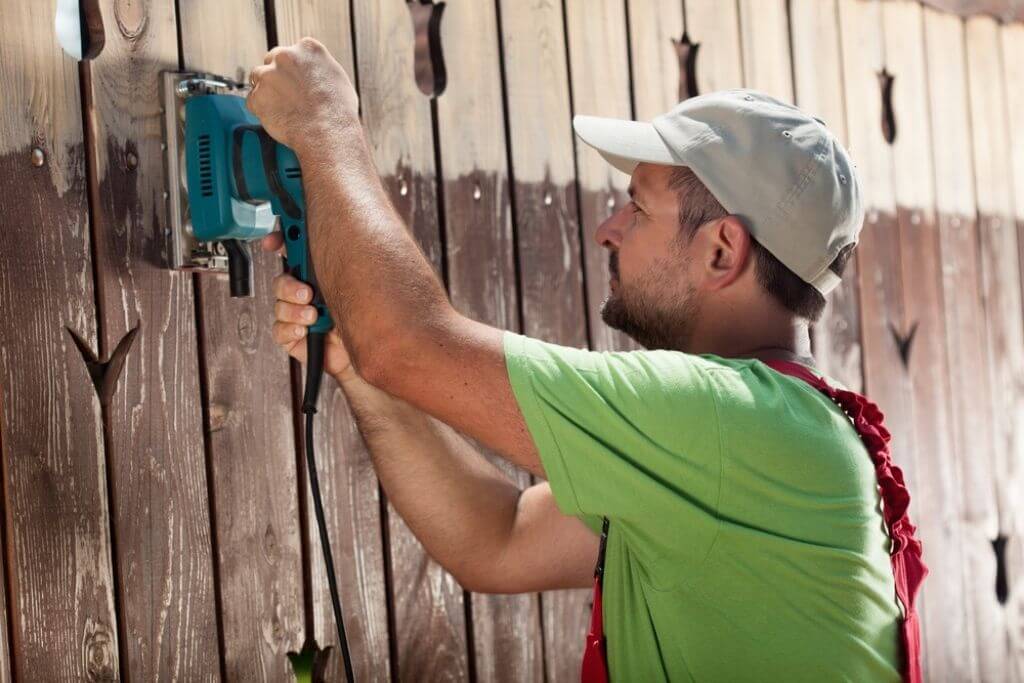
There are different methods for taking paint off a surface, such as heat guns or paint strippers.
But if you plan to buy a power sander anyway, why not use it for the job?
Getting the right sander can bring a whole new look to your furniture or house. From dull old paint to flaking layers, it can prepare your surface for a fresh new coat. This is the preferred way to pull this off.
Check out this article to know the best sander for removing paint you should have.
We will also show you some important points you need to know about sanding away paint.
Table of Contents
- Top Rated Sanders For Removing Paint From Wood
- Types of Sanders To Remove Paint
- 5 Best Sanders For Removing Paint – Reviews
- How To Choose The Best Sander To Remove Paint
- Tips For Using A Sander When Removing Paint
- Frequently Asked Questions (FAQs)
- How To Use Sanders Together With Other Tools To Remove Paint?
- Besides Wood, Can I Remove Paint From Other Surfaces With A Sander?
- Should I Use A Sander To Remove Paint From Walls?
- What Are Advantages And Disadvantages Of Sanding Away Paint?
- How To Test Lead Paint Before Sanding?
- My Sander Couldn’t Reach Some Detail Areas. What Should I Do?
- Is An Orbital Sander Good For Removing Paint?
- Which Is The Best Grit Sandpaper For Removing Paint?
- Conclusion
Top Rated Sanders For Removing Paint From Wood
Types of Sanders To Remove Paint
Here are popular sander types you can make use of to take paint or varnish off a surface.
Belt Sanders

The high work rate of belt sanders makes them excel at broad, flat surfaces. You can use handheld belt sanders to remove paint layers from horizontal or vertical surfaces.
They are the ideal sander for stripping off multiple paint layers from floors, weatherboards, benches, and tables. This type of sander is also a fantastic choice if you plan to remove paint and thin the surface at the same time.
However, this high-power nature is also its weak point. Belt sanders can remove a thick layer of wood. They are not easy to control, and they may destroy the surface’s details.
Palm Sanders
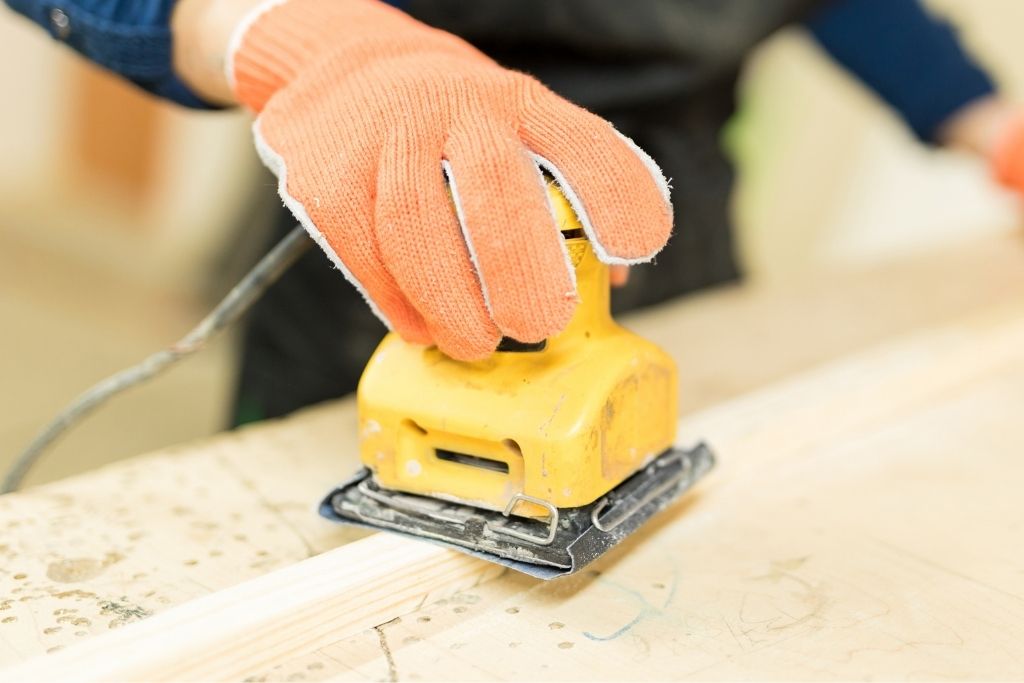
They are small electric sanders that you can hold and operate with one hand. You will have to clip a piece of sandpaper into their square base.
The bottom of these machines moves in small circles to sand away the wood’s topcoats.
They aren’t the most powerful tool around, but palm sanders can create great finishing. There is a smaller chance of you damaging the surface by accident.
However, palm sanders can’t remove a large amount of material quickly. Don’t expect them to remove paint as fast as belt sanders.
You should use these tools when you don’t have a big area of paint to remove.
Random Orbital Sanders

These sanders use round sanding pads at the bottom.
Random orbital sanders create random sanding patterns with a combination of spinning and orbital movements. A big advantage of this combined motion is that it won’t leave swirl marks behind like most palm sanders.
They are compact tools and sit between the belt and the palm models regarding aggressiveness.
These versatile electric sanders can work with both heavy-grit sandpaper and fine-grain polishers. They can remove material faster than a palm sander. But they are still handheld tools you can control easily.
Random orbital sanders are a great choice for medium and large furniture. However, working at difficult angles and tight corners can be cumbersome.
Detail Sanders
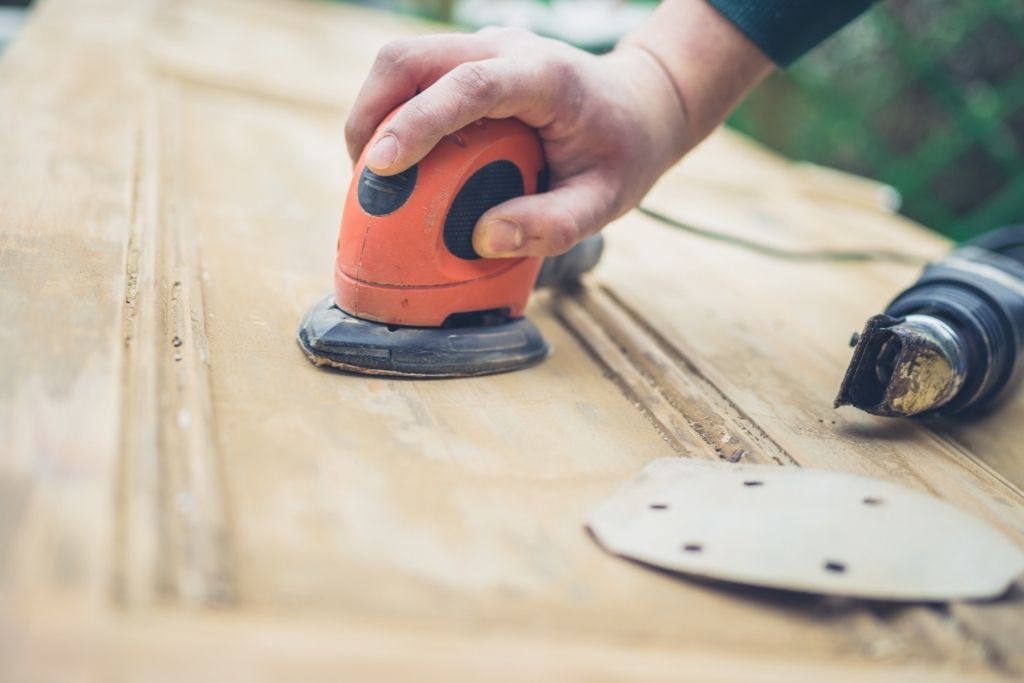
Also known as mouse sanders, they have a small pointed base that can easily get into corners. Detail sanders also have superior accuracy.
These small tools are the king of tight spaces due to their top-notch maneuverability.
In many cases, they are the only effective sanding tool for carved and textured surfaces. You can reach into all the nooks and crannies of a complex project.
Detail sanders can also add the final touch before you stain and refinish the wooden surface. It is obvious that you should never use them to remove paint on a big, flat area.
A common usage is to pair it with a random orbital sander. This combination can take on a wide array of paint removal cases.
Use the random orbital sander on flat areas for maximum work rate. Then turn to the detail sander in contoured surfaces, narrow spaces, and acute angles.
5 Best Sanders For Removing Paint – Reviews
1. BOSCH GET75-6N – Electric Orbital Sander
Specifications:
- Sander Type: Two-mode random orbital disc sander
- Power: 7.5 amp, Corded
- Disc Size: 6 inches
- Speed: 3,300-7,300 OPM, 290-640 RPM
- Dust Collection: Yes
- Weight: 5.7 pounds
The Bosch GET75-6N is the most interesting model in this list. This powerful sander has not just one but two changeable working modes.
Normally, it has a typical random orbital mode with a no-load speed range of 3300-7300 OPM. But it can switch to the direct-drive turbo mode with a greater material removal rate. This amazing versatility allows you to remove paint from a wide range of surfaces.
The turbo mode, which comes close to a small belt sander, can rip off the most stubborn paint. For more delicate workpieces, you can always rely on the random orbit mode. It is more gentle to the wood and less likely to damage it.
The Bosch GET75-6N may not have the most compact size on this list. But there is no doubt it has the most ergonomic design.
In addition to a long body, it has a side handle for total control. You can detach and mount this auxiliary handle to any side to your liking.
The vibration control in this power sander is not terrible by any stretch. It seems to be the result of the dual-bearing pad mount. We didn’t feel much hand fatigue with the Bosch GET75-6N after my tests.
Dust extraction is always a top issue when sanding away paint. Bosch puts this concern to rest with the GET75-6N’s efficient dust collection system.
This system accepts a wide range of 35mm and 22mm anti-static and normal vacuum hoses. For 1-1/2″ and 1-1/4″ hoses, you can always buy the vacuum adapter from Bosch.
Remember that this is a passive dust collection system, so it won’t work without a shop vacuum cleaner and hoses.
Compared to the first generation, current GET75-6N units come with even more hole patterns. This means you can use it with different types of sanding papers.
It is important to note that this sander gets hot quickly during the turbo mode. If you plan to strip off paint aggressively for a long session, a belt sander is still a better choice.
- Suitable for both fine finishing large surfaces and rough stock removal
- Powerful but still easy to control
- Excellent surface finish
- Compatible with a wide range of vacuum hoses
- Sturdy construction
- The multihole pad system allows for different abrasive discs
- Pricey
- Need two hands to operate
- It can be hard to buy replacement parts
2. DEWALT Random Orbit Sander (DWE6423)
Specifications:
- Sander Type: Random orbit sander
- Power: 3 amp, Corded
- Disc Size: 5 inches
- Speed: 8,000-12,000 OPM
- Dust Collection: Yes
- Weight: 2.9 pounds
Not everyone needs the immense power of its aggressive turbo mode. At a much lower cost, the DEWALT random orbital sander offers similar performance in many situations.
The DEWALT DWE6423 places the dust-sealed switch and dial at a convenient position. You can access it with ease to adjust the speed between 8,000 and 12,000 OPM. This variable speed control is particularly useful when you need to sand between paint coats.
Compared to the Bosch dual-mode sander, this DEWALT model is much lighter at 2.9 pounds. You operate it with one hand by hanging onto the top grip or grabbing around the neck.
Some may find this lack of an auxiliary handle a downside. But for most paint removal applications, you should be fine.
The DEWALT random orbital sander doesn’t transfer much vibration to the housing. Most of it stays on the base and doesn’t make its way to the handle.
The manufacturer credits the added counterweight with this. And we must say, it does a great job of preventing our hands from getting tired.
It is pleasant to move this sander across the painted surface. The rubber handle provides a comfortable grip for control, while the low profile allows you to get closer to the surface for accuracy sanding.
Overall, we was also pleased with the performance of the dust collection system. It can’t just keep the sanding pad clean but also reduce the health hazards of paint dust.
But you must hook up this sander to a vacuum to guarantee this dust capture ability. The provided dust bag has a one-hand locking system, which is handy. But it can still leave out some amount of dust.
- Reasonably priced
- Great for rough and finish work
- Lightweight and easy on the hand
- Swapping pads is easy
- Ergonomic design with little vibration
- Come with a dust bag
- Can only connect to 1-1/4″ hoses
- Need to buy a separate adapter for the dust port
3. Porter-Cable Random Orbital Sander (382)
Specifications:
- Sander Type: Random orbit sander
- Power: 1.9 amp, Corded
- Disc Size: 5 inches
- Speed: 12,000 OPM
- Dust Collection: Yes
- Weight: 3.6 pounds
To put it simply, the Porter-Cable model is among the most affordable sanders that can still yield decent paint removal results.
This tool can remove old coats of paint or varnish from the furniture with ease, as long as it isn’t heavy-duty work.
The motor provides 1.9 Amps of power, it doesn’t overheat under reasonable use. You can use it for 3 hours straight to prepare a surface without issues.
This small tool can stand up to a significant amount of abuse. You can even use it to strip paint off your hardwood floors if you can’t rent a floor sander.
You may need to replace the sanding pads after that. But for an emergency fix, the Porter-Cable sander isn’t a bad choice.
Like the DEWALT sander, this model uses the regular 5-inch, 8-hole sanding pads. We didn’t notice any swirl marks on the surface after sanding, which is great for an inexpensive sander.
The Porter-Cable sander provides a small dust bag in the box. It does a decent job of capturing small paint particles that come off.
But the vacuum hose connection between the bag and the dust port isn’t reliable. It can pop off at times, and you may have to use another hand to hold it while sanding.
Our main turnoff is the lack of speed adjustments. It can limit the range of surfaces and materials this sander can handle.
- Great value for money
- Have a soft start
- Consistent and smooth finish
- Can take down high spots and specks of paint quickly
- Sealed 100-percent ball-bearing construction makes it durable and sturdy
- Low-power motor, not suitable for heavy-duty work
- Not the most comfortable fit
- Operation on/off switch is quite difficult
4. Wagner Spraytech 0513040 Orbital Disc Sander
Specifications:
- Sander Type: Orbital disc sander
- Power: 3.2 amp, Corded
- Disc Size: 4-1/2 inches
- Speed: 2,600 RPM
- Dust Collection: No
- Weight: 3.65 pounds
If you need the best sander for removing paint on the exterior of your house, have a look at the Wagner PaintEATER.
Most of its performance comes from its unique sanding discs. Unlike other models in this list, this tool employs proprietary 4-1/2″ discs to get the job done.
These discs have an open, spun-fiber design, which has two major advantages. You can notice that there is not much paint dust clogging the disc. This astonishing result is possible even though the Wagner PaintEATER has no dust collection system.
On top of that, these high-performance discs can feather and strip paint on various materials without getting damaged.
They can tolerate some screw and nail heads you haven’t removed from the exterior yet. When running into uneven areas, the Unique Flex-Disc system makes the disc conform to the surfaces.
Another highlight of these discs is how gentle they are on surfaces. The powerful 3.2-amp motor provides an aggressive removal capability.
If you notice some stubborn paint chips, just operate the sander on its edge. It will feather the paint and smooth out the surface for you. But the Wagner PaintEATER won’t damage your masonry, trim, or siding.
This sander moves across the exterior much faster than manual scraping. It will take you only a fraction of the time.
Even if you only buy this for this sole purpose, it’s still worth it. Pair it with a pressure washer, and you can prepare your wall for repainting.
- Perfect sander for scraping flaking and damaged exterior paint
- Safe for common siding and trim
- Ergonomic design, easy handle with multiple positions hand to reduce fatigue
- Work efficient on various surfaces
- Affordable price
- Have to use non-standard discs
- The cost of replacement discs can add up fast
- Heat up quickly
- Don’t have dust collection
5. Makita 9403 Belt Sander
Specifications:
- Sander Type: Belt sander
- Power: 11 amp, Corded
- Belt Size: 4×24 inches
- Speed: 1,640 ft/min
- Dust Collection: Yes
- Weight: 13 pounds
This list wouldn’t be complete without a belt sander. This high-power tool from Makia is a perfect choice if you need to remove paint in large sections.
The 11-amp motor and 1640 ft/min speed give it enough muscle to quickly removing paint from wood. Instead of investing in a professional floor sander, you save some money with the Makita 9403.
We are a big fan of how quiet this sander is. It doesn’t create as much noise with only 84dB, and this creates comfort when operating.
Besides the 4×24-inch belt, the long cord allows the Makita 9403 to work on large projects. You can throw it over your shoulder to keep it out of the way.
We didn’t feel much vibration either. And the handles offer a secure grip, so this power machine can’t get out of control.
The dust bag can swivel full 360 degrees as well, so it shouldn’t be a nuisance. But it has a plastic connection to the body. An accident happens, and it could break off, blowing dust straight to your face.
This sander isn’t lightweight by any means. With a weight about 13 pounds, vertical sanding on the wall can be difficult.
But it also means you don’t need to apply much pressure to remove paint. Just guide it along the lines, and the sander will handle the rest of the work.
- Suitable for heavy-duty projects like floors or deck boards
- Aggressive, fast paint and stock removal
- Large front grip create comfort operate
- Long cord for better maneuverability
- The construction seals the motor and bearings from dust
- More expensive than other woodworking sanders
- The exhaust can get very hot
- Quite heavy, not ideal for vertical or overhead work
How To Choose The Best Sander To Remove Paint
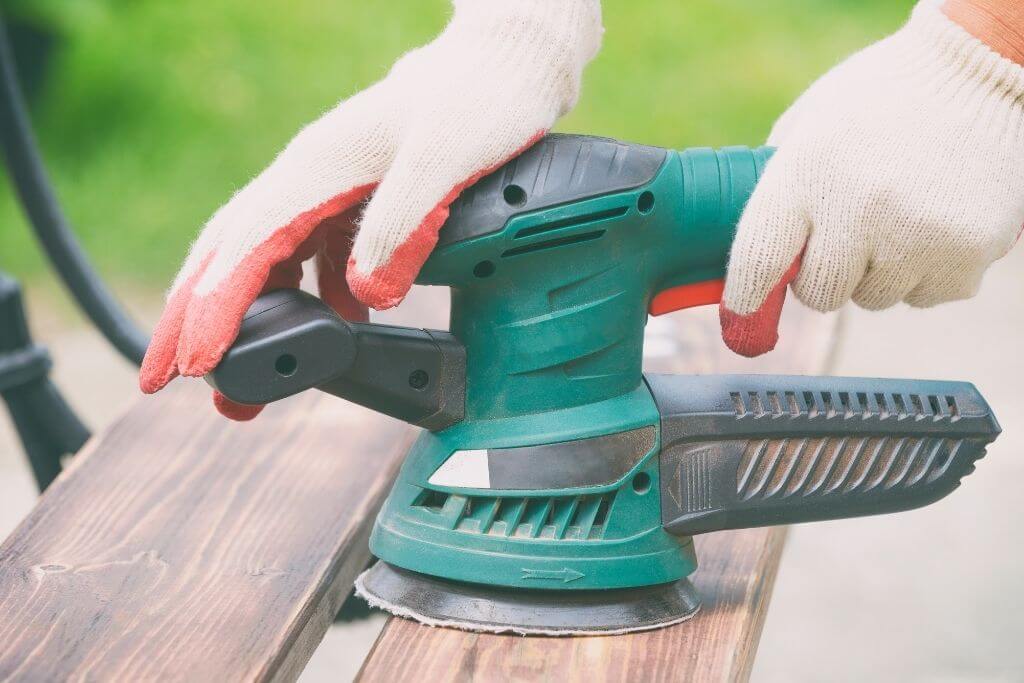
Power
The more powerful the motor, the stronger the paint removal ability you have. Even models of the same design can come with different power ratings.
Make sure that your sander has enough muscle to get the job done but is not too powerful to ruin your work.
Also, consider the material and other projects you intend to use the sander with.
Getting rid of paint from metal parts is a more extensive task, so you’re more likely to need a heavy-duty sander. But it can get hot easily and carries a heavy, powerful motor.
If your work involves only carpentry projects, a powerful around 3 – 6 amp can help you remove paint without those issues.
Speed
Many woodworkers tend to stick to the top speed their sanders offer. But variable control is always nice to have. It gives you the chance to adjust and adapt to different materials and surfaces.
This speed adjustment also means you can choose the aggression level before sanding. Many also prefer to work at slower speeds at the final smoothing steps.
Not every sander model offers this feature. It can bring up the cost compared to fixed-speed sanders. But in many cases, the extra cost is well worth it.
Ease Of Use
A comfort grip is an important aspect of sanders. It creates a huge night-and-day difference in how you do your job. A secure and comfortable grip doesn’t only allow you to control the sander better but also reduces fatigue.
For belt and heavy-duty disc sanders, look for models with a large grip or side handle. They provide better control, especially when you have to stand and sand at awkward angles.
This isn’t necessary for less powerful models like palm or random orbital sanders. They often have grip soft with different hold options so you don’t need to worry about them slipping away from your hands or fatigue.
Vibration control is also important. An extended period of paint removal is burdensome, and you don’t want your hands to get tired. Many recent models use features like counterweights to solve this issue.
Pay attention to the positions of buttons and switches on the sander as well. Make sure that these controls are easy to reach. Also, the sander should be easy to change sanding pads or sandpaper.
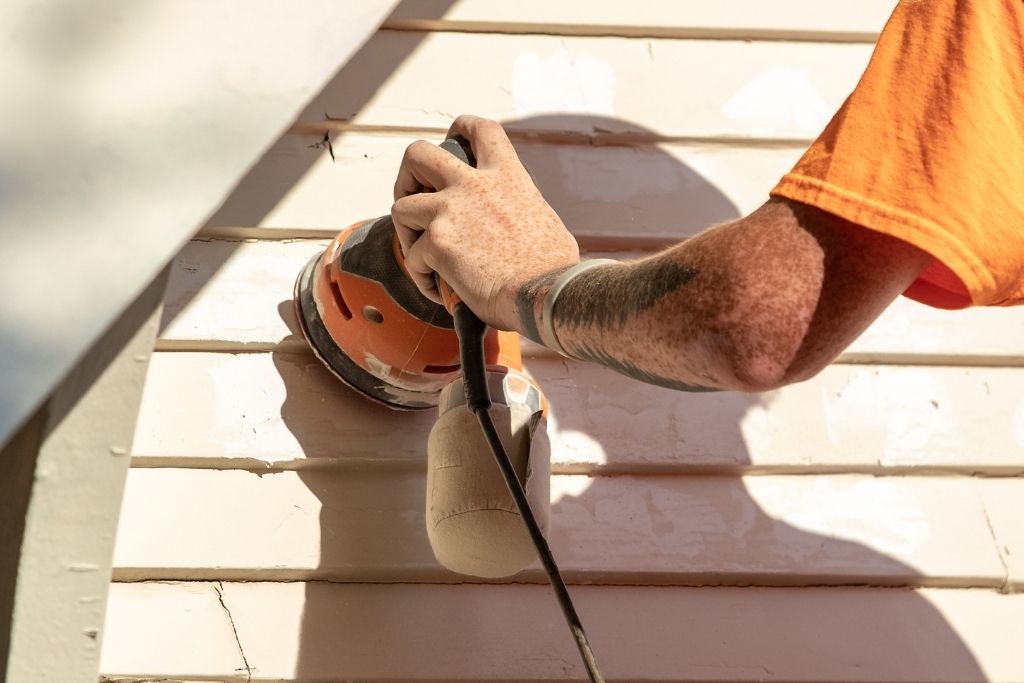
Runtime
This is only important if you prefer a cordless model. Many power sanders don’t use electricity out of sockets. These cordless models rely on built-in batteries to run the motor instead.
Battery-powered sanders offer superior maneuverability as you don’t have to worry about the range and tangled cords anymore. However, a cordless sander will introduce another concern for you: runtime.
When sanding big surfaces like tabletops, take into account the maximum amount of time your sander can operate.
Rougher materials require more power to sand and remove paint than softer surfaces. The big motor of a belt sander also means it runs out of power faster than a cordless detail or palm sander.
If your work calls for several hours of paint removal a day, consider a corded sander. You will have to deal with the cord, but at least there is no worry about your runtime.
Dust Collection System
Dust from sanding paint can be quite harmful, especially if you are dealing with old paint layers.
Make sure your sander has a functional dust collection mechanism. Many models allow you to use either a provided dust bag or connect the sander to a shop vac.
Versatility
Not many woodworkers buy a sander with the sole purpose of removing paint. Think about other work you may have to use a power sander with your projects.
In addition to stripping paint, these tools can flatten rough wood, sand intricate molding, and finish furniture.
But if you don’t have other uses in mind, a specialized sander for paint removal is fine too.
Noise
More powerful sanders tend to produce louder noises. You may don’t hear much when they run with no load. But in operation, they can scream a lot.
Prolonged exposure to loud sounds can lead to problems like hearing loss. Even in non-serious cases, it can make you lose concentration or cause stress.
Hearing protection is available. But whenever possible, go for quiet sanders. They will cause a small disturbance to your family or neighbors as well.
Don’t buy models with more power ratings than you need. Some manufacturers boast about how little noise their products create. These models often have a decibel level printed on the label or in the product description.
Cost
Different sanders have various kinds of prices as well as depend on features and power. Big, heavy-duty models as belt sanders can cost several times more than compact ones.
Take into account your budget and purposes. If you don’t have much money, it is not wise to buy a pricey model when a cheaper model can get the job done.
Pay attention to both upfront and long-term costs.
For example, random orbital sanders use pre-cut sanding pads with a specific hole pattern. They are quick to swap in and out. But the cost of those pads can add up quickly in the long term.
Extras
Safety features are never unnecessary, even though sanders aren’t the most dangerous tool in a workshop. Emergency stop or trigger-lock systems can prevent injuries from happening.
Manufacturers may include accessories like carrying cases and additional discs/pads. They are a great bonus as your sander can work out of the box without buying extra sandpaper.
Tips For Using A Sander When Removing Paint
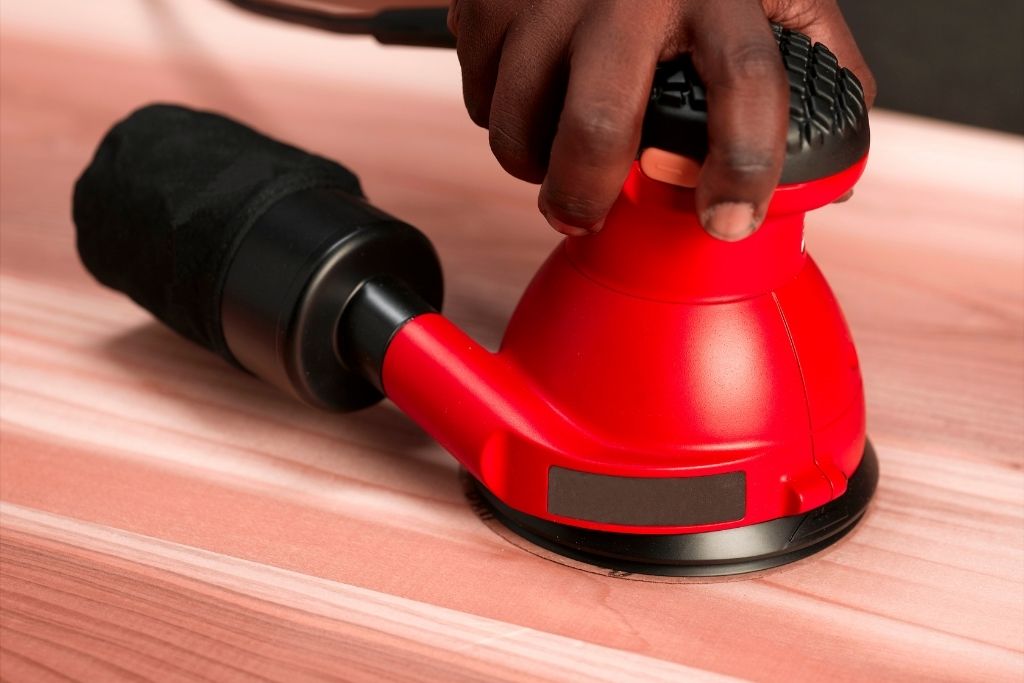
Choose Correct Sandpaper Grits
Like other sanding tasks, you should work through a grit sequence from coarse to finer sandpaper. If you are removing paint from wood, start coarse sandpaper of around 80 grit.
Once most paint coats on top have been peeled off, move to 150 and 220-grit abrasive. They will allow for precise sanding jobs and reduce the amount of wood unnecessarily worn away.
With old paint, you should use a powerful sander as the random orbital or belt sander to remove quickly and efficiently.
How To Remove Paint Without Damaging Your Surfaces
Some preparations are needed so the sander can take the paint off properly.
Thoroughly clean the surface before you carry out any removal steps. Use household cleaner, dish soap, and degreasing cleaner. Allow the surface to dry completely.
Only apply enough force so the sander can do its job. Too much pressure can damage the surface.
Between sandpaper changes, brush away dust from the surface. When you are done with sanding, use a damp cloth to wipe the surface and remove any dust or debris left behind.
Safety
Lead paint can be very dangerous. Homes built during and before the 1978s in the US can contain lead-based paint. It can sit below newer paint coats if the surface has multiple paint layers.
Make sure you do a test to find out its existence on the surface. Avoid using sanders to remove lead-based paint.
Sanding can disperse tiny lead particles into the air and lead to severe health problems.
Even safer paint products can introduce serious issues if you inhale them.
Use the dust collection of your sander. Hook it into a shop vacuum if you anticipate a lot of dust. Wear face masks and eyewear and work in a well-ventilated area.
Frequently Asked Questions (FAQs)
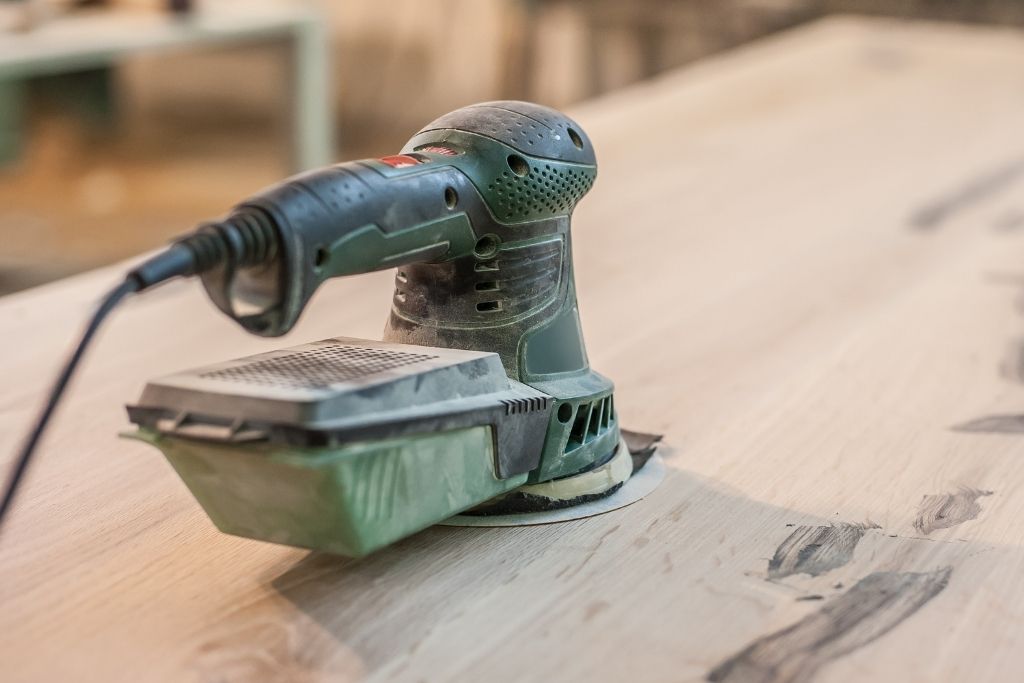
How To Use Sanders Together With Other Tools To Remove Paint?
After using a paint stripper or heat gun, you can turn to a sander to remove any paint left on the surface.
Besides Wood, Can I Remove Paint From Other Surfaces With A Sander?
Sanders can work with other materials like drywall or metals. They are also a common tool for stripping paint on cars.
Should I Use A Sander To Remove Paint From Walls?
A compact sander works fine with low walls. For overhead areas, you can think about more specialized tools like drywall sanders.
What Are Advantages And Disadvantages Of Sanding Away Paint?
Sanding is easy to do if you are already a woodworker. You don’t have to learn about working with other tools like paint strippers. It is also a quicker method than chemicals.
Power sanders are versatile tools. You can use them for other woodworking tasks.
However, the nature of sanding is to remove materials. Sanders can remove some of the material beneath the paint as well. Only use them if you can manage or don’t mind this.
But it is a poor choice when you need to avoid chances to its textures. To remove every last mark of paint from wood, you may have to take off a huge amount of materials.
How To Test Lead Paint Before Sanding?
Many DIY test kits are available at hardware stores. You can also hire a certified inspector or risk assessor to test it for you.
My Sander Couldn’t Reach Some Detail Areas. What Should I Do?
You can use a detail sander or apply a paint stripper. A heat gun can also work if it can reach into those areas.
Is An Orbital Sander Good For Removing Paint?
Yes. it has a decent removal rate to sand off paint from several surfaces like furniture, hardwood floors, decks, and walls. It’s good for small areas.
Which Is The Best Grit Sandpaper For Removing Paint?
Use coarse sandpaper (around 60 – 80 grit) to remove the paint layers on top. Then turn to finer grits (150-220) to create a good finish without damaging the surface.
Conclusion
So, which is the best sander for removing paint that’s suitable for you?
We would give the crown to the Bosch GET75-6N. It is rare to see such a versatile and powerful tool in a compact design like that.
This dual-mode tool already offers one of the most impressive paint removal abilities among random orbital models. But it goes further and allows you to take off stock even faster with a turbo mode.
Its respiratory hazard-reducing great dust system along with control easy with a side handle is another plus point.
The DEWALT DWE6423 random orbital sander is another general-purpose option you can go for. It strips away paint in an efficient way and leaves a great finish behind. We also appreciate its low vibration rate and counterweight design.
In general, all sanders can remove paint to some extent. But their designs and feature sets play a huge role in the final results.
Sanding is convenient if you already know woodworking. You can use the sander for other purposes besides removing paint or varnish.










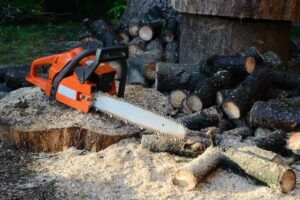
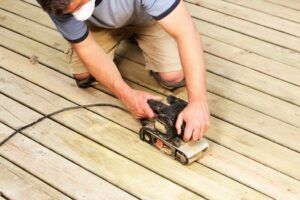

![9 Best Pole Saws of 2023 [Ultimate Guide] 9 Best Pole Saws of 2023 [Ultimate Guide]](https://handykeen.b-cdn.net/wp-content/uploads/2021/03/best-pole-saw-300x200.jpg)
![How To Start A Woodworking Business [Ultimate Guide] How To Start A Woodworking Business [Ultimate Guide]](https://handykeen.b-cdn.net/wp-content/uploads/2021/10/woodworking-business-1-300x200.jpg)
